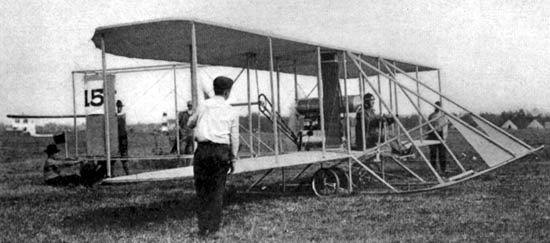Cal Rogers and Vin Fiz
Today, we fly across America -- for the first time. The University of Houston's College of Engineering presents this series about the machines that make our civilization run, and the people whose ingenuity created them.
Calbraith Perry Rodgers was born in 1879. His middle name came from his grandfather Admiral Matthew Perry who first opened Japan to commerce, and his granduncle Oliver Perry, hero of the Battle of Lake Erie in the War of 1812. Cal Rodgers studied at Virginia and Columbia, and he'd been a football player.
His six-foot-four frame might've suited him better for foot-ball, but he studied flying with the Wright Brothers in 1911. The year before (with airplanes only seven years old) William Randolph Hearst had offered the then-staggering sum of fifty thousand dollars for the first thirty-day flight across America.
Rodgers, who'd gone into barnstorming and also set a world's endurance record in the air, wanted Hearst's prize. He sold the soft drink maker, Vin Fiz, on sponsoring him. Vin Fiz agreed to pay three dollars a mile for the flight from Brooklyn's Sheepshead Bay, to Pasadena. They outfitted a railway car to follow with a repair shop, parts, and other supplies. They even brought along an automobile for liaison service.
Rodgers bought a Wright airplane for five thousand dollars and he set out on September 17, with his 41-day-old pilot's license. He flew 105 miles on the first day. The next day he crashed in a chicken yard and it took two days to repair his airplane, as well as his scalp.
That continued. He had some good days and some bad. He'd used up his thirty days by the time he reached Kansas City. But Hearst's time limit had been just as unreasonable as that huge purse. Vin Fiz was still getting publicity. Rogers kept flying.
On November 3rd, just as he reached California, an engine cylinder exploded. Two more days of repair. He finally reached Pasadena and a crowd of ten thousand cheering people. Never mind that he'd missed the prize by months. Or that his airplane was so rebuilt that only the original rudder and oil pan remained. Cal Rodgers had been first to fly across the United States.
But it wasn't enough. He'd begun at edge of the Atlantic. He would end with his wheels in the Pacific. He took off and crashed yet again, breaking both legs, a collarbone and several ribs. A month later Rodgers flew those last twenty miles. He landed at Long Beach, taxied his wreck of an airplane until his wheels touched the Pacific Ocean, and got out with the help of crutches.
His feat had taken 84 days, not including that last twenty miles. A trained athlete might've walked the distance in the same overall time. He'd spent 82 hours in the air, and his average flying speed had been 51 miles an hour.
Four months later, Rodgers was back at it. He flew an exhibition over the water at Long Beach, using a new airplane. He zoomed through a flock of gulls, intending only to scatter them. But one lodged in his rudder, he lost control, crashed, and died. And, call me morbid, but the question that I cannot shake is -- how did the sales of Vin Fiz fare, back in that long-ago fall of 1911?
I'm John Lienhard, at the University of Houston, where we're interested in the way inventive minds work.
T. Gwynn-Jones, Wings Across the Pacific. Atglen, PA: 1991, Chapt. 1.
For more on Cal Rodgers see:
CALBRAITH PERRY RODGERS
For more on the Vin Fiz, click here.
Listener Andy Schmidt of St. Paul writes to point out an important fact that I did not mention in this script. It was that Cal Rogers was deaf. When one considers how strongly early flyers depended on all their senses, Roger's feat becomes even larger.
Vin Fiz was a subsidiary of the Armour Meat-Packing Company and it appears not to've done well. According to one newspaper along Rodger's route, the stuff was "a fine blend of river water and horse slop." Rodgers crew agreed that "you had to sneak up on the stuff to get it down." (See the excellent Hearst Prize website link in the text.)

Rodgers' airplane was a Wright Model B, like the one shown above. He named his: Vin Fiz, after the new grape drink that his flight was advertising. (Image from W. Kaempffert, The New Art of Flying, New York:Dodd, Mead and Co., 1911)